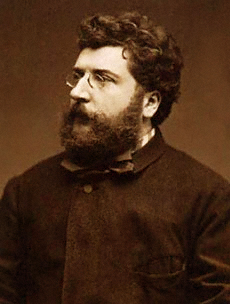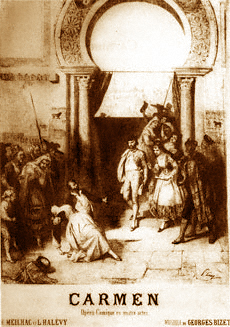

Georges Bizet (1838-1875), a French composer and pianist, composed the opera Carmen in 1874. Bizet came from a musical family, and was admitted to the Paris Conservatoire a few weeks before he turned ten. While there, his teachers included Pierre Zimmerman and Charles Gounod. As a note of explanation, although Gounod was not an official teacher at the Conservatoire, he happened to be married to Zimmerman's daughter, Anna, and often substituted for the ailing Zimmerman. Both teachers saw great potential in Bizet, and Gounod even asked Bizet to assist him with musical projects (Bizet worked as an arranger on Gounod's First Symphony). Bizet developed a close friendship with Gounod and regarded him as an influential mentor. In 1857, Bizet won the Conservatoire's most prestigious competition, the Prix de Rome, which enabled him to spend almost three years in Italy, leisurely traveling, absorbing the music and culture of the Italian people, and composing.
When Bizet returned from Italy, he began to receive commissions for operas and theater music. His first major opera, The Pearl Fishers, was not well-received when it premiered in 1863. Bizet continued composing operas and other music such as incidental music for Alphonse Daudet's play L'arlésienne. When the drama was first performed in October, 1872, it had a disappointing reception. Bizet quickly extracted four pieces, scored them for full orchestra, and in November, 1872, presented them as a concert version orchestral suite. Bizet's orchestral suite L'arlésienne was an immediate success, and it remains popular to this day. [41]

Although Bizet composed in a variety of musical genres such as orchestral and chamber music, piano music, and choral works such as oratorios, masses and sacred and secular songs, his primary focus as a composer was opera. Bizet left approximately 30 finished, incomplete or projected operas at the time of his early death at the age of 36. He is best known today for his opera Carmen. Carmen was not well-received when it premiered in Paris in March 1875. The plot, set in a Spanish atmosphere, focused on passion and betrayal, and ended with the death of the heroine, Carmen, when she was murdered by her ex-lover. The French critics labeled Bizet's Carmen as immoral. Even though Carmen was performed 45 times during the year of its premiere, it was not considered a success until October, 1875 when it was produced in Vienna and received acclaim for performances there. From that point on, Carmen began to achieve international praise, and it remains one of the most popular operas performed today. Unfortunately, Bizet never knew how successful his opera would become. He died of a heart attack in June, 1875, just three months after Carmen premiered in Paris. [42] [43]

TECHNIQUE TIPS: Carmen’s Habanera aria is one of Bizet's most well known arias. An aria is an elaborate vocal solo with instrumental accompaniment, used in genres such as an opera, oratorio or cantatas. “L’amour est un oiseau rebelle” (“Love is a rebellious bird”), the entrance aria sung by Carmen, is commonly referred to as the Habanera, a term that refers to a style of Afro-Cuban dance music with a distinct rhythm. This piece is an arrangement of Bizet's Habanera. Bizet based Habanera on a Spanish song called El arreglito. Bizet thought El arreglito was a Spanish folksong, and when he learned it actually had been composed by the Spanish composer Sebastián Yradier, Bizet gave Yradier credit in the score. The Afro-Cuban habanera rhythm plays a prominent part in Bizet's Habanera. Try to capture the lively habanera rhythm in your playing. When you see slurred notes with a dot over or under them, this indicates slurred, martelé bowing should be used (another name for this bowing technique is slurred staccato). Martelé is a French term meaning hammered. Each note is percussive, and commences with a sharp accent or "pinch" at the beginning of the note, followed by a quick release. To achieve this effect, before you set your bow in motion, apply a "pinch" or "bite" for articulation. There also are tenuto signs, a line drawn over or under the note __ to indicate the note should be played in a sustained or broad manner and held for its whole value. Make sure that your smooth, tenuto triplet bow strokes clearly contrast with the pinch of the martelé bowing. Although most pieces end with a down-bow, this arrangement ends with an up-bow flourish. You may want to experiment with ending the piece with a down-bow and then an up-bow, and then decide which bowing you prefer. [44]
© Copyright 2025 RK Deverich. All rights reserved.
Although this online violin class is provided free of charge, all rights are reserved and this content is protected by international copyright law. It is illegal to copy, post or publish this content in any form, and displaying any of this material on other websites, blogs or feeds is prohibited. Permission is given for individual users to print pages and perform music from this website for their personal, noncommercial use.